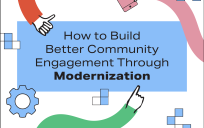This article is an excerpt from GovLoop’s recent market trend, “Hybrid Cloud: A Path to IT Modernization.” Download the full report here.
Government organizations face several challenges when implementing the kind of IT modernization that will improve service delivery to citizens. They’ve been stymied by several factors, including resource prioritization, the ability to procure services quickly, as well as technical issues, according to a 2017 report to the president on IT modernization.
“In order to enhance the speed of service delivery, cut costs, maximize security and productivity, and provide stability, agencies are looking for ways to become more agile with their resources, and find tools that will support dynamic workloads,” said Zohaib Khan, Application Modernization Practice Lead for Red Hat North America Public Sector.
Agencies need the ability to provision cloud services quickly and manage those services with transparency and ease across multiple clouds. At the same time, agencies must still manage manual processes that are not scalable.
Plus, determining the best way to modernize applications often raises cultural hurdles around development, operations and security. A top challenge agencies face is delays and cultural friction that come with provisioning server resources internally. “The process can take months or years for agencies working out of their own data center,” said Rob Patrick, a Cloud Specialist with Red Hat Public Sector.
Wherever possible, agencies want to scale out applications, accommodate dynamic workloads, provision and install applications automatically and have tools that enable management and visibility of multiple cloud services across the agency. They must also account for virtualized infrastructure and physical servers, including legacy applications that cannot be moved to a public cloud.
Many agencies are mixing the security, accessibility and privacy that cloud can offer by turning to hybrid cloud. But while hybrid cloud offers a path toward IT modernization, it isn’t always easy to adopt and manage. “Despite understanding the potential benefits that a hybrid cloud provides, it’s challenging to implement systemic change,” Patrick said.
“Many IT leaders view hybrid as a safer alternative to moving everything to the cloud at once,” according to GSA’s 2017 Hybrid Cloud Almanac. “Hybrid allows lessons learned to be discovered that are agency-specific, and factors in that not all systems are suited for the cloud.”
To create a frictionless experience for managing public and private clouds, agencies need a hybrid cloud management platform that enables them to view and manage multiple clouds as a single entity. This type of management includes provisioning, patching, securing and updating IT resources in the cloud.
Using this hybrid platform, agencies can also take advantage of more self-service and automated options, which enhance productivity and lower production costs. IT departments can spend less time and resources managing the complexities of multi-cloud integration and orchestration and focus instead on modernizing workloads and applications.
Additionally, IT staff can easily transfer applications and tools to the cloud environment, due to the portability provided by containerization. In other words, agencies can move workloads to where they make sense, without having to worry about retooling applications for integration or risking security.
Altogether, a hybrid cloud management platform enables agencies to easily control what is happening, where it’s happening and how it’s happening in their cloud environment. In the next section, we detail best practices for embracing hybrid cloud to drive IT modernization.






Leave a Reply
You must be logged in to post a comment.